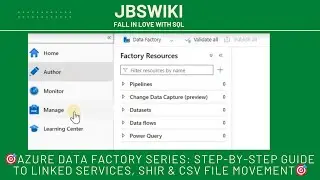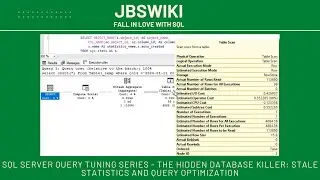📚SQL Server Query Tuning Series: Improving Query Performance with Merge Join Optimization📚
на канале: JBSWiki
📚SQL Server Query Tuning Series: Improving Query Performance with Merge Join Optimization📚
📚 Basics of Merge Joins
Merge joins are a fundamental operation in SQL Server for combining rows from two sorted input sets. They work by iterating over each row in both inputs and merging them based on a common key. This is particularly efficient when both input sets are already sorted.
🔍 How Merge Joins Work
Imagine you have two tables, Orders and Customers, and you want to find all orders along with customer details. A merge join can efficiently combine these tables if both are sorted by the customer ID.
💡 Merge joins are preferred when:
Both input sets are large and sorted.
There's an equality join condition.
The inputs are indexed on the join keys.
Many-to-Many Merge Joins Explained
⚙️ Understanding Many-to-Many Relationships
A many-to-many relationship in merge joins occurs when there are multiple rows in each input that match the join condition. This can create performance issues because it requires more complex processing to ensure all matches are found.
Example:
Let's say we have a table of Orders and another table of Products. If a single order can contain multiple products and a product can appear in multiple orders, we have a many-to-many relationship.
Why Many-to-Many Can Be Problematic:
Increased Complexity: Handling multiple matches increases the complexity of the join operation.
Performance Overhead: Additional processing time is required to match each row from one input to multiple rows in the other input.
Resource Consumption: More memory and CPU resources are consumed to manage these operations.
Performance Impact of Many-to-Many Merge Joins
📉 Performance Challenges
When the "Many-to-Many" property is set to true in a merge join, it can significantly affect performance. Here’s why:
Higher CPU Usage: The SQL Server engine needs to perform more comparisons and iterations.
Increased Memory Usage: Storing intermediate results of multiple matches consumes more memory.
Longer Query Execution Times: The overall time to execute the query can increase due to the additional processing.
Real-World Example:
Consider a report that generates sales data by joining large tables of orders and customers. If there are multiple orders per customer and vice versa, enabling many-to-many merge joins could slow down the report generation significantly.
🛠️ Optimization Techniques
To improve performance, you can modify the many-to-many property in merge joins. Here are the steps:
Identify Problematic Queries:
Use SQL Server Profiler or Extended Events to identify slow-running queries.
Check the execution plans for merge joins with the many-to-many property.
Review Indexes:
Ensure that the join columns are indexed properly.
Consider creating composite indexes to cover the join keys.
Modify Merge Join Properties:
Use query hints to influence the join strategy.
Consider rewriting queries to avoid many-to-many relationships if possible.
Step-by-Step Guide: Modifying Merge Join Properties
🔧 Practical Example
Let’s go through a step-by-step guide on how to modify the many-to-many property for merge joins.
Step 1: Identify the Query
SELECT Orders.OrderID, Customers.CustomerName
FROM Orders JOIN Customers
ON Orders.CustomerID = Customers.CustomerID
Step 2: Analyze the Execution Plan
Open SQL Server Management Studio (SSMS).
Execute the query and view the execution plan.
Look for the merge join operator and check if the many-to-many property is set to true.
Step 3: Optimize Indexes
CREATE INDEX idx_orders_customerid ON Orders(CustomerID);
CREATE INDEX idx_customers_customerid ON Customers(CustomerID);
Step 4: Apply Query Hints
If necessary, apply query hints to modify the join strategy. For example, you can use the OPTION clause to force a specific join type.
SELECT Orders.OrderID, Customers.CustomerName
FROM Orders
JOIN Customers
ON Orders.CustomerID = Customers.CustomerID
OPTION (MERGE JOIN)
Step 5: Reevaluate the Execution Plan
Rerun the query and examine the new execution plan.
Verify that the many-to-many property is no longer causing performance issues.
Best Practices for Merge Joins
✅ Best Practices
Here are some best practices to ensure efficient merge joins:
Proper Indexing: Always ensure that the join columns are indexed.
Query Optimization: Regularly review and optimize queries to avoid many-to-many relationships.
Use Statistics: Keep statistics up to date to help the SQL Server engine make better decisions.
Monitor Performance: Continuously monitor query performance and execution plans.
Q&A Section
❓ Q&A
Q1: Can all many-to-many relationships be optimized?
Not always. It depends on the specific scenario and data distribution. However, most can be improved with proper indexing and query tuning.
Q2: Are there any tools to help with query optimization?
Yes, SQL Server provides tools like the Query Store, Profiler, and Extended Events to help analyze and optimize queries.



![Thanos vs Thor | Avengers: Sonsuzluk Savaşı (2018) | Türkçe Dublaj [1080p]](https://images.videosashka.com/watch/agVfb0KyT00)



























